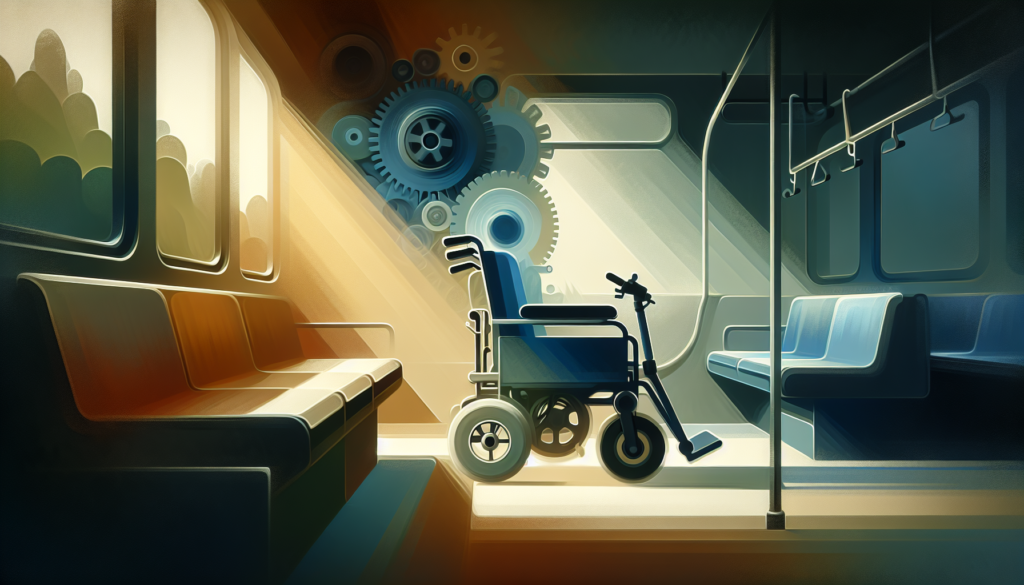
When choosing an electric wheelchair, one of the most crucial decisions you’ll face is the type of battery that powers it. Lithium-ion batteries and lead-acid batteries each offer different benefits and drawbacks, impacting the overall performance, range, and maintenance of your mobility aid. For instance, the Edegree EW6 features a lithium battery that provides a range of 10-15km with a lightweight design, while the Edegree EW1 uses a heavier lead-acid battery that offers a longer range of up to 20km. Understanding these differences with us at EKO Life MY can help you make a more informed choice that suits your mobility needs.
Understanding Battery Types in Electric Wheelchairs
When it comes to electric wheelchairs, the type of battery used can greatly impact performance, range, and overall user experience. Lithium-ion batteries, like those found in the Edegree EW6, offer a range per charge of 10-15km with a lightweight design of only 14.8kg. These batteries typically have a longer lifespan and quicker charging times of around 6-8 hours, making them suitable for users who require mobility throughout the day. The Edegree EW6 is powered by a dual motor, allowing for various speeds up to 8 km/h and a climbing ability of less than 10° degrees, thus providing efficient operation compared to traditional options.
On the other hand, lead-acid batteries, such as those used in the Edegree EW1, boast a longer range per charge at 20km but add significant weight, coming in at 38kg. While they are more economical at a price of RM 2,499 and can support a weight of 100kg, they take up to 6 hours to charge and generally have a shorter lifespan. The EW1 also provides a lower forward speed of 6 km/h and a climbing ability of 13° degrees. Ultimately, the choice between lithium-ion and lead-acid batteries will depend on individual needs, balancing weight, range, and speed for the best electric wheelchair experience.
Lithium-Ion Batteries: Advantages and Disadvantages
Lithium-ion batteries are rapidly becoming the preferred choice for electric wheelchairs, offering several advantages over traditional lead-acid batteries. One of the primary benefits is their higher energy density, allowing for a longer range per charge. For instance, the Edegree EW6 with a lithium battery has a range of 10-15 km, while the Edegree EW1 with a lead-acid battery offers only about 20 km. Additionally, lithium-ion batteries are lighter, which means less overall weight for the electric wheelchair, making it easier to maneuver and transport, as seen with the Edegree EW6 weighing only 14.8 kg compared to the 38 kg of the Edegree EW1.
The faster charging times (6-8 hours) also enhance convenience, as users spend less time waiting to recharge their electric wheelchair. However, there are some disadvantages to consider as well. Lithium-ion batteries can be more expensive initially; the Edegree EW6 is priced at RM 4,388 due to its advanced technology. There is also a potential risk of overheating if not managed properly, although modern technologies have largely mitigated these concerns. Nevertheless, for users looking for efficiency and lighter weight, lithium-ion batteries in electric wheelchairs remain a compelling option, balancing cost against performance and convenience.
Lead-Acid Batteries: Pros and Cons
Lead-acid batteries have been a long-standing choice in the electric wheelchair market due to their lower cost and established technology. They typically provide a reliable power source, offering a range of 20km per charge for models such as the Edegree EW1. However, they come with several limitations. These batteries are heavier, as seen in the EW1’s 38kg weight, which can make maneuverability more challenging. Additionally, lead-acid batteries require more frequent maintenance and have a shorter lifespan compared to lithium-ion alternatives. Their slower charging time of 6 hours can be a disadvantage for users needing quick recharges during the day.
On the flip side, lead-acid batteries have a decent performance regarding their climbing ability, handling inclines up to 13 degrees effectively. This makes them suitable for specific terrains but might fall short for users who require a more versatile battery option. As with any power source, it is essential to weigh the costs against your mobility needs. Ultimately, while lead-acid batteries are often cheaper and effective, the additional weight and maintenance requirements may influence your decision, making it crucial to assess your lifestyle needs when choosing an electric wheelchair battery type.
Performance Comparison: Range and Charging Times
When it comes to selecting the right battery for your electric wheelchair, understanding the performance differences between lithium-ion and lead-acid batteries is crucial. For instance, the Edegree EW6, equipped with a lithium battery, offers a range of 10-15 km per charge, making it suitable for short to medium trips. It also takes about 6-8 hours to fully charge, which is quite efficient given its range capabilities.
On the contrary, the Edegree EW1, which uses a lead-acid battery, provides a more substantial range of up to 20 km per charge. Charging takes only 6 hours, which is relatively quick, but the performance in terms of weight and maneuverability is significantly different due to the battery’s heft—38 kg compared to the EW6’s 14.8 kg with the battery included. Moreover, the climbing abilities highlight another difference, as the EW1 can handle inclines of up to 13 degrees, while the EW6 manages under 10 degrees.
The varying speeds further accentuate these distinctions, with the EW6 reaching a forward speed of 0-8 km/h compared to EW1’s 0-6 km/h. This performance comparison shows how selecting between a lithium-ion and a lead-acid battery will significantly impact your mobility experience in an electric wheelchair, greatly influencing your travel range and overall ease of use.
Weight and Portability Considerations

When it comes to selecting an electric wheelchair, weight and portability are crucial factors to consider, especially regarding the type of battery used. Lithium-ion batteries, like those found in the Edegree EW6, are much lighter than their lead-acid counterparts. The Edegree EW6 weighs just 14.8 kg, including the battery, making it significantly easier to maneuver and transport.
On the other hand, the Edegree EW1, which utilizes a lead-acid battery, weighs 38 kg. This substantial difference in weight not only affects the overall portability of the wheelchairs but also the user’s ability to load and unload the chair with ease. A lighter electric wheelchair with a lithium-ion battery allows for greater independence, particularly for users who may need to lift the device into a vehicle or navigate tight spaces.
Additionally, lithium-ion batteries offer better energy density, meaning they provide more power without adding extra weight. This feature is particularly beneficial for users who require longer ranges and faster speeds, as seen with the Edegree EW6, which can travel up to 15 km per charge at a forward speed of up to 8 km/h. In contrast, the Edegree EW1’s lead-acid battery limits its range to 20 km at a lower speed of 6 km/h. Therefore, when considering weight and portability for electric wheelchairs, lithium-ion batteries emerge as the optimal choice for those seeking both efficiency and ease of use.
Cost Analysis: Lithium-Ion vs Lead-Acid
When considering the cost of batteries for electric wheelchairs, it’s essential to weigh both the initial purchase price and the long-term value. Lead-acid batteries, like those used in the Edegree EW1, are typically more affordable upfront, priced at RM 2,499. However, lead-acid batteries generally have a shorter lifespan and lower efficiency compared to lithium-ion batteries.
For instance, while the Edegree EW6, which utilizes a lithium battery, comes at a higher cost of RM 4,388, the investment pays off due to the lithium battery’s longevity and performance. This means potentially fewer replacements and lower operating costs over time, especially considering the rechargeable nature and faster charging capabilities of lithium batteries, which can be a game changer for everyday users.
Additionally, the efficiency of lithium-ion batteries contributes to their overall cost-effectiveness. With a range per charge of 10-15km from the Edegree EW6’s lithium battery and only requiring 6-8 hours for a full charge, users can enjoy longer use periods compared to the Edegree EW1’s lead-acid battery, which allows for a range of about 20km on a 6-hour charge. This efficiency not only enhances the user experience but also helps justify the higher initial investment for lithium batteries when weighing cost against performance in electric wheelchairs.
Environmental Impact of Battery Types
When considering the environmental impact of battery types used in electric wheelchairs, lithium-ion and lead-acid batteries present distinct profiles. Lithium-ion batteries, like those found in the Edegree EW6, are known for their efficiency and longer lifespan. They produce fewer emissions during manufacturing and possess a higher energy density, which means they can store more energy in a smaller size, ultimately contributing to a lighter wheelchair that has a reduced carbon footprint during transportation. Additionally, lithium batteries are recyclable, minimizing the adverse effects on the environment after their life cycle ends.
On the other hand, lead-acid batteries, such as those used in the Edegree EW1, although widely used and less costly, have greater environmental challenges. The production and disposal processes for lead-acid batteries can lead to significant toxic waste concerns due to their lead content. Furthermore, they are bulkier and heavier, which can affect their usability in electric wheelchairs and contribute to higher emissions during manufacturing and transport. As consumers become more environmentally conscious, transitioning to lithium-ion technology might not only provide better performance but also aligns with a more sustainable approach to mobile independence in electric wheelchairs.
Choosing the Right Battery for Your Needs
When selecting the right battery for your electric wheelchair, it’s essential to consider the type of battery that best meets your needs. Lithium-ion batteries, like the one found in the Edegree EW6, offer a range per charge between 10-15 km, with a faster charging time of 6-8 hours. Weighing only 14.8 kg, these batteries are not only more lightweight but also provide more energy density. This means that despite their smaller size, they can deliver more power, allowing for a longer lifespan and less frequent replacements. Their efficiency is further highlighted by their ability to maintain performance over time, making them an excellent choice for those who prioritize mobility and convenience.
On the other hand, lead-acid batteries, such as the Edegree EW1, generally come with a longer range of about 20 km per charge but are heavier, weighing 38 kg. Although they are more affordable at RM 2,499 compared to the lithium-ion option, their bulky design and slower charging capabilities can be a drawback. As a result, for users who need a lightweight and efficient solution, lithium-ion batteries might be the better choice, while lead-acid is suitable for those focusing on budget and longer operational distances. Ultimately, your specific requirements in terms of weight, range, and budget will guide your selection between these two battery types.
Making the Right Choice for Your Electric Wheelchair

In conclusion, selecting the right battery type for your electric wheelchair is crucial for achieving optimal performance and convenience. Lithium-ion batteries, such as those found in the Edegree EW6, offer significant advantages, including a lighter weight, longer range per charge, and shorter charging times. This makes them incredibly appealing for users who value portability and extended use without frequent interruptions. On the other hand, lead-acid batteries, like the one in the Edegree EW1, are more budget-friendly and may provide adequate support for those who prioritize cost over performance.
Ultimately, the choice between lithium-ion and lead-acid batteries largely depends on your individual needs and lifestyle. If you frequently travel long distances or require a lightweight option, investing in a lithium-ion battery may be worthwhile. Conversely, if you are looking for a less expensive option that still offers reliability, a lead-acid battery might serve you well. Whichever you choose, ensuring that your electric wheelchair is equipped with the right battery will enhance your mobility and overall experience.

Not impressed by the summary, too brief and lacks details.
I think this blog could be more engaging with some visuals.
Hello Ethan Wong, thank you for your thoughtful feedback! We agree that visuals can make our blog posts more engaging. We’ll definitely consider adding more images and multimedia content to our future posts. If you have any suggestions or ideas, please don’t hesitate to share them with us. You can reach us at [email protected] or call us at +60 3-7890 3042.
Sounds like an interesting topic, but could you share more about it?
Hi Amanda, thanks for your interest in our blog! I’d be happy to provide more information about the topic. Unfortunately, it seems like we haven’t posted the blog yet. Could you check back with us soon? In the meantime, if you have any specific questions or topics you’d like to learn more about, feel free to let us know and we’ll do our best to assist you. You can reach us at [email protected] or +60 3-7890 3042. We’re looking forward to hearing from you!
I’m intrigued by the new perspective on this topic.
Love the title, but it’s a bit vague. Can you share the main points of the blog?
Thank you for your feedback, Emma Tan. We appreciate your interest in our blog and would be happy to provide more information. Our latest blog post focuses on ‘Empowering Enthusiasts through Affordable, Quality Products and Professional Servicing’. We explore the importance of affordability, quality products, and professional servicing in supporting the cycling, ebike, and escooter community. If you have any specific questions or would like more details, please feel free to contact us at [email protected] or +60 3-7890 3042.